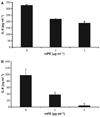Activity of antimicrobial peptide mimetics in the oral cavity: II. Activity against periopathogenic biofilms and anti-inflammatory activity
- PMID: 21040516
- PMCID: PMC3086835
- DOI: 10.1111/j.2041-1014.2010.00591.x
Activity of antimicrobial peptide mimetics in the oral cavity: II. Activity against periopathogenic biofilms and anti-inflammatory activity
Abstract
Whereas periodontal disease is ultimately of bacterial etiology, from multispecies biofilms of gram-negative anaerobic microorganisms, much of the deleterious effects are caused by the resultant epithelial inflammatory response. Hence, development of a treatment that combines anti-biofilm antibiotic activity with anti-inflammatory activity would be of great utility. Antimicrobial peptides (AMPs) such as defensins are naturally occurring peptides that exhibit broad-spectrum activity as well as a variety of immunomodulatory activities. Furthermore, bacteria do not readily develop resistance to these agents. However, clinical studies have suggested that they do not represent optimal candidates for exogenous therapeutic agents. Small-molecule mimetics of these AMPs exhibit similar activities to the parent peptides, in addition to having low toxicity, high stability and low cost. To determine whether AMP mimetics have the potential for treatment of periodontal disease, we examined the activity of one mimetic, mPE, against biofilm cultures of Aggregatibacter actinomycetemcomitans and Porphyromonas gingivalis. Metabolic assays as well as culture and biomass measurement assays demonstrated that mPE exhibits potent activity against biofilm cultures of both species. Furthermore, as little as 2 μg ml(-1) mPE was sufficient to inhibit interleukin-1β-induced secretion of interleukin-8 in both gingival epithelial cells and THP-1 cells. This anti-inflammatory activity is associated with a reduction in activation of nuclear factor-κB, suggesting that mPE can act both as an anti-biofilm agent in an anaerobic environment and as an anti-inflammatory agent in infected tissues.
© 2010 John Wiley & Sons A/S.
Figures




Similar articles
-
Development of an in vitro periodontal biofilm model for assessing antimicrobial and host modulatory effects of bioactive molecules.BMC Oral Health. 2014 Jun 28;14:80. doi: 10.1186/1472-6831-14-80. BMC Oral Health. 2014. PMID: 24972711 Free PMC article.
-
Effects of chitosan particles in periodontal pathogens and gingival fibroblasts.J Dent Res. 2013 Aug;92(8):740-5. doi: 10.1177/0022034513494816. Epub 2013 Jun 20. J Dent Res. 2013. PMID: 23788611
-
Melatonin Receptor Agonists as the "Perioceutics" Agents for Periodontal Disease through Modulation of Porphyromonas gingivalis Virulence and Inflammatory Response.PLoS One. 2016 Nov 10;11(11):e0166442. doi: 10.1371/journal.pone.0166442. eCollection 2016. PLoS One. 2016. PMID: 27832188 Free PMC article.
-
Antimicrobial peptides and periodontal disease.J Clin Periodontol. 2011 Mar;38 Suppl 11:126-41. doi: 10.1111/j.1600-051X.2010.01664.x. J Clin Periodontol. 2011. PMID: 21323710 Review.
-
Origin and function of the cellular components in gingival crevice fluid.Periodontol 2000. 2003;31:55-76. doi: 10.1034/j.1600-0757.2003.03105.x. Periodontol 2000. 2003. PMID: 12656996 Review. No abstract available.
Cited by
-
Polymeric systems of antimicrobial peptides--strategies and potential applications.Molecules. 2013 Nov 14;18(11):14122-37. doi: 10.3390/molecules181114122. Molecules. 2013. PMID: 24241155 Free PMC article. Review.
-
Lipidated cyclic γ-AApeptides display both antimicrobial and anti-inflammatory activity.ACS Chem Biol. 2014 Jan 17;9(1):211-7. doi: 10.1021/cb4006613. Epub 2013 Nov 1. ACS Chem Biol. 2014. PMID: 24144063 Free PMC article.
-
Cystatin C: immunoregulation role in macrophages infected with Porphyromonas gingivalis.PeerJ. 2024 Apr 30;12:e17252. doi: 10.7717/peerj.17252. eCollection 2024. PeerJ. 2024. PMID: 38708345 Free PMC article.
-
Antibiofilm peptides against oral biofilms.J Oral Microbiol. 2017 Jun 14;9(1):1327308. doi: 10.1080/20002297.2017.1327308. eCollection 2017. J Oral Microbiol. 2017. PMID: 28748031 Free PMC article.
-
In Vitro and In Vivo Anti-infective Potential of Thymol Against Early Childhood Caries Causing Dual Species Candida albicans and Streptococcus mutans.Front Pharmacol. 2021 Nov 19;12:760768. doi: 10.3389/fphar.2021.760768. eCollection 2021. Front Pharmacol. 2021. PMID: 34867378 Free PMC article.
References
-
- Borrell LN, Burt BA, Taylor GW. Prevalence and trends in periodontitis in the USA: the [corrected] NHANES, 1988 to 2000. J Dent Res. 2005;84:924–930. - PubMed
-
- Cochran DL. Inflammation and bone loss in periodontal disease. J Periodontol. 2008;79:1569–1576. - PubMed
-
- Davey ME. Techniques for the growth of Porphyromonas gingivalis biofilms. Periodontol 2000. 2006;42:27–35. - PubMed
Publication types
MeSH terms
Substances
Grants and funding
LinkOut - more resources
Full Text Sources
Other Literature Sources
Medical

